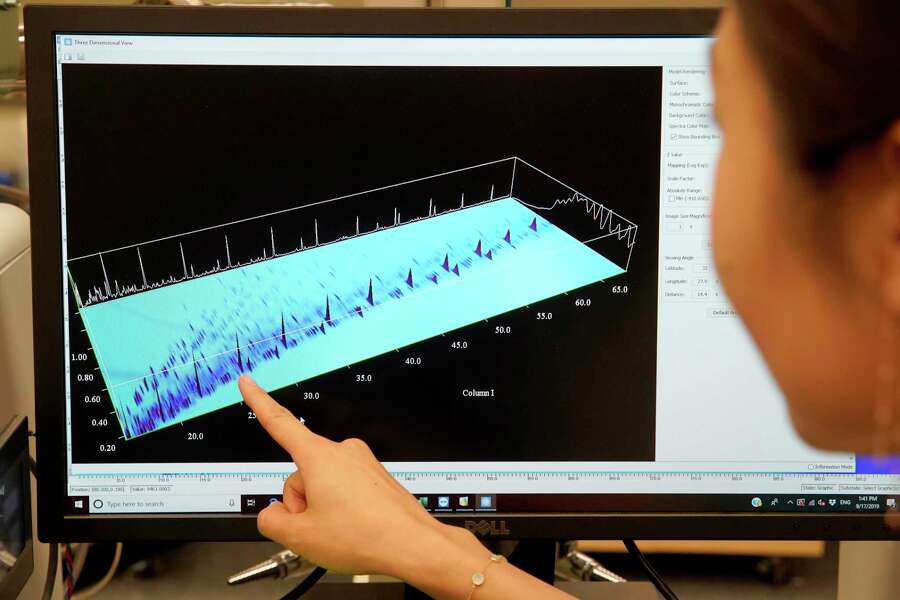Faye Liu and Jiang Wu are revealing the secret lives of oil wells from chemical fingerprints gathered thousands of feet below the Earth’s surface.
The information produced by their company, RevoChem, helps address some of the biggest problems facing the shale oil industry by assisting companies to drill fewer wells, extract more oil and potentially market crude by its point of origin.
RevoChem can identify where a drop of crude originated within 10-to-15 feet of accuracy. The secret is understanding that oil comes from plants and animals, which came to rest millennia ago between different layers of rock.

Faye Liu, RevoChem founder and CEO, talks about a 3D rendering of the geochemical fingerprints in one drop of oil shown in the lab at the University of Houston Energy Research Park Tuesday, Sept. 17, 2019, in Houston. RevoChem analyzes geochemical fingerprints in oil and rock formations.
“There are actually thousands of compounds that are in crude oil that are naturally occurring that you can understand as a natural tracer,” said Liu, a geochemist with a doctorate from Indiana University. “Each of the layers is carrying different geochemical information because, as we jokingly say, a different dinosaur died there, so it’s coming from a different biological source.”
Experts have long graded oil by viscosity, sulfur content and a few other chemical properties. But until recently, geochemists have not looked any closer.
“Traditionally, the geochemistry method can resolve about a hundred compounds; we are able to resolve over 2,000,” Liu said.
Liu first worked on chemical fingerprints while employed by ConocoPhillips, where she examined how the oil’s chemical make-up changed through the lifespan of a well. But she theorized that a closer analysis could reveal what was happening more than 5,000 feet below the surface and a half-mile from the wellhead.

Samples of drill cuttings are shown in the lab at RevoChem at the University of Houston Energy Research Park Tuesday, Sept. 17, 2019, in Houston. RevoChem analyzes geochemical fingerprints in oil and rock formations. Faye Liu is founder and CEO of RevoChem and her husband, Jiang Wu, is co-founder.
Liu shared her theories with her husband Jiang Wu, who has a doctorate in biochemistry and was working to improve medical imaging at the Texas Medical Center.
Wu knew from his work that he could build the better instrument Liu needed. In March 2018, despite having a mortgage and a 2-year-old daughter, Liu and Wu quit their jobs to build a new instrument, write specialized code and develop a database that would allow them to change the oil industry.
Wu’s instruments can take oil from a gram of rock — collected during drilling — and identify over 2,000 compounds. Liu has built a library of over 3,000 rock samples from 260 wells in nine oil basins.
“If you give me a drop of crude oil, I can immediately tell you where it’s coming from, which layer it’s coming from, and which basin,” Liu, RevoChem’s CEO, said.
The information can help companies improve efficiency.
North American oil companies drill long, horizontal wells along seams of oil in shale rock and then use hydraulic pressure to break the oil out. But no one knows for sure the size of the fracture or where the oil will flow.
Companies drill parallel wells to maximize production. If petroleum engineers space them too far apart, they leave oil behind. If they space them too close, the oil flows from one well into another, and they’ve wasted money. Until now, engineers could only guess at what’s happening below the surface.
By chemically fingerprinting the oil from an exploration well, RevoChem can identify which oil comes from 5,000 feet, 5,050 feet, 5,100, and so on. If oil from 5,100 feet is showing up in a fractured well drilled at 5,000 feet, the engineer can avoid spacing wells too close together.
“Using RevoChem technology, we’re able to identify where the better-quality rocks are and where more oil is,” Ed Caamano, senior vice president for geoscience at Advance Energy Partners, said. “I don’t know of another company that can provide this level of resolution to the oils that are within the formation.”
The data can also help engineers understand why a well produces a lot in the beginning, but then peters out, by monitoring where the oil is coming.
Well spacing, fracturing technique and oil flow are the biggest challenges facing the shale industry. In its first year, RevoChem worked with 14 of the 20 largest producers in the prolific Permian Basin. The company is operating from labs at the University of Houston Technology Bridge until it finishes construction on a new lab.
RevoChem’s technology can also help address another growing question: what oil comes from which location. Buyers are beginning to ask for unblended barrels from specific locations, the Reuters news agency reported.
Liu and Wu, both Chinese immigrants who met in the U.S., took an enormous risk starting their own business. But they are a classic Houston story: Immigrants who came to work in the energy and health care sectors but ended up starting their own revolutionary company.
Read it from Houston Chronicle – Photos as published by Houston Chronicle ( Melissa Phillip, Houston Chronicle / Staff photographer )



